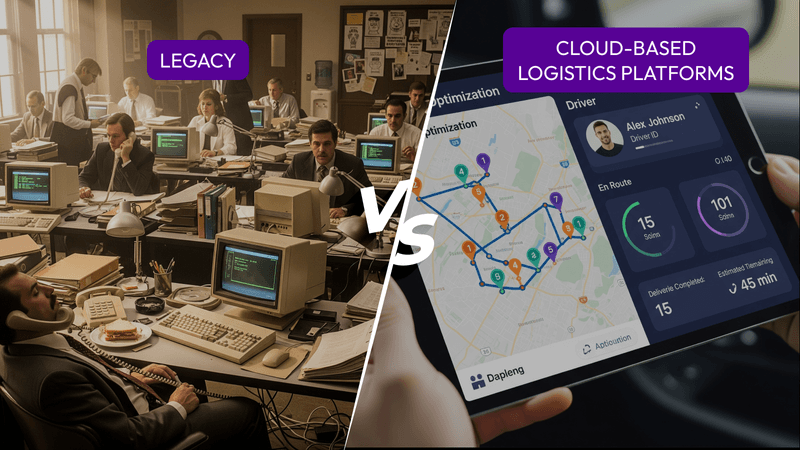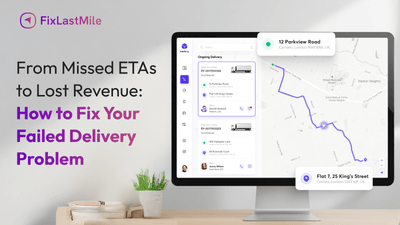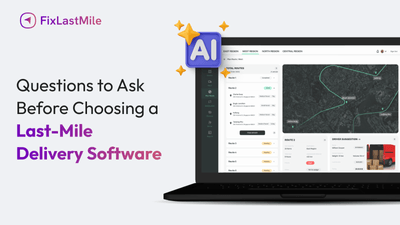You might feel your current logistics system is “good enough.” After all, it’s been running your operations for years without falling apart.
But if you’re still using legacy logistics systems, you could be missing out on huge opportunities to scale and grow.
These older systems simply weren’t built for today’s fast-moving world. They slow your operations, inflate your costs, and frustrate your customers.
But there is a solution and a better option than this legacy system that is: Cloud-based logistics platforms.
This logistics platform offers flexibility, speed, and automation. The system also helps you deliver a seamless experience for your customers while cutting your operational expenses.
In this blog, you’ll discover why holding onto legacy systems is holding you back and what steps you can take to modernize your logistics operations.
The Hidden Costs of Legacy Logistics Systems
You might think sticking with your legacy logistics systems is a safe bet because they've worked fine for years.
But the reality is different. These outdated systems are costing you more than you think.
Let us explore below how.
Scalability Challenges
As your business grows, legacy systems simply can’t keep up.
These old systems weren’t built to handle today’s demand. Especially when the customer expectations and delivery volumes continue to increase.
Legacy platforms are often slow, clunky, and difficult to scale.
In fact, 90% of IT leaders report that outdated legacy systems severely limit their organization’s ability to innovate and grow.
If your logistics system can’t scale with your business, you’re likely losing valuable opportunities.
Customer Experience (CX) Problems
Another critical issue with legacy logistics platforms is their impact on customer experience (CX).
With manual data entry, inefficient route planning, and lack of real-time tracking, these systems can’t deliver the seamless service customers expect today.
Customers want real-time updates and accurate delivery windows. A delay or inaccurate tracking could push them straight to the competition.
As per one of the reports, according to 41% of customers, a late delivery will result in them never returning to that business. With legacy systems, customer satisfaction takes a hit.
Increased Operational Costs
Legacy systems these days are both – frustrating and expensive. Maintaining outdated software comes with hidden costs like manual processes to inefficiencies.
You might not realize it, but relying on a manual delivery management system is a huge drain on resources.
Research shows that companies using legacy logistics systems can spend 30% more on labor compared to those using modern and cloud-based solutions.
When you’re working with a cloud-based logistics platform, you get automation, real-time tracking, and smarter route optimization, all of which lower operational costs and drive profitability.
Now that we’ve looked at the hidden costs of legacy systems, let’s explore why cloud-based logistics platforms are the key to overcoming these challenges.
Legacy vs Cloud-Based Logistics Platforms: Why It Matters

When it comes to logistics systems, choosing the right one can make or break your business’s ability to scale.
Legacy logistics systems might have served you well in the past, but the world of logistics has changed dramatically. Today, cloud-based logistics platforms are the future, and here’s why.
Feature Comparison: Outdated vs Advanced
Legacy systems often rely on outdated infrastructure that isn’t designed to meet modern needs.
Manual processes, lack of automation, and limited integration with other tools make these systems inefficient and slow.
They can’t handle real-time tracking or instant updates. In fact, the legacy system leaves your business stuck in the past.
On the other hand, cloud-based logistics platforms are designed with modern demands in mind.
These platforms offer real-time tracking, AI-powered route optimization, and seamless integration with other systems like e-commerce platforms, payment gateways, and customer service tools.
With cloud-based systems, you can access and manage data from anywhere, anytime.
Advantages: Flexibility and Automation
One of the biggest advantages of cloud-based logistics platforms is flexibility.
They can scale easily with your business. It allows you to expand into new regions, handle increased order volumes, or add more drivers without a hitch.
Legacy systems are limited in this regard. It often requires manual interventions and major infrastructure upgrades when you need to scale.
Additionally, cloud-based solutions offer automation. Tasks like route planning, order assignment, and customer communication can be fully automated. This reduces human error and saves valuable time.
In contrast, legacy systems often require manual inputs at each stage which further leads to inefficiency and delays.
Benefits: Cost Savings and Improved CX
Switching to a cloud-based logistics platform doesn’t just make your operations more efficient. It also saves you money.
With automation, real-time visibility, and smart route optimization, you can reduce operational costs by cutting down on fuel usage. Plus, it improves delivery times, and reduces manual labor.
But the biggest benefit is an - Improved customer experience (CX). Customers expect fast and reliable service with real-time updates.
Cloud-based logistics systems give you the ability to deliver just that while keeping customers happy and more likely to return.
In fact, 41% of customers report that they won’t return if their delivery is late or inaccurate.
With cloud-based solutions, you can exceed their expectations, every time.
Now that you understand the major differences, let's dive into how you can begin replacing manual delivery dispatch systems and making the shift to more efficient, automated solutions.
How to Replace Manual Delivery Dispatch Systems
Manual delivery dispatch systems are one of the biggest obstacles to efficiency in logistics.
If you’re still relying on spreadsheets, phone calls, or paper-based systems to manage deliveries, you’re wasting valuable time and leaving room for human error.
From delayed deliveries to missed opportunities, manual dispatching can quickly spiral out of control.
Challenges with Manual Systems
Manual dispatch systems create numerous challenges for logistics businesses:
- Human Error: Manual data entry is prone to mistakes and often leads to incorrect delivery addresses, missed routes, or duplication of orders. A misplaced address can result in delays and frustrated customers.
- Inefficiency: Without automated route planning, drivers may take longer routes, increasing fuel costs and delivery times.
- Delayed Communication: With manual dispatching, communication between drivers and the office is often slow and inefficient, leading to delays and misunderstandings.
In fact, 61% of logistics companies report that manual processes are among the top reasons for their inefficiency (source).
Step-by-Step Guide to Transition
Moving from manual delivery dispatch systems to an automated solution can seem overwhelming, but it doesn’t have to be. Here’s how you can make the transition smoothly:
- Evaluate Current System: Take stock of your current process and identify where manual processes are slowing you down. Focus on areas like dispatch scheduling, route planning, and driver communication.
- Choose the Right Cloud Platform: Select a cloud-based logistics platform that integrates real-time tracking, automated dispatching, and route optimization. Look for platforms that offer scalability, AI-driven solutions, and seamless integration with your existing tools.
- Integrate the System: Migrate your data to the new platform and integrate it with other software you use. Ensure your team is trained to use the new system efficiently.
- Monitor and Optimize: Once the system is live, continuously measure key performance metrics like delivery times, fuel consumption, and customer satisfaction. Cloud-based platforms make it easier to track performance and optimize in real time.
Benefits of Automation
The shift to automated systems offers numerous benefits for logistics businesses:
- Time Savings: Automation eliminates manual entry and allows you to schedule and route deliveries instantly. This can save businesses up to 40% in operational time source.
- Cost Reduction: By improving route efficiency and reducing human error, businesses can cut fuel costs, driver hours, and administrative overhead.
- Increased Accuracy: With automation, deliveries are more accurately routed and tracked, reducing the chance of errors and improving customer satisfaction.
Switching to automated systems gives you the tools to streamline operations and stay ahead of competitors.
Now that you understand how to automate your delivery dispatch system, let's explore how to create a logistics system modernization roadmap for the best results.
Why Modern Alternatives to Legacy Software Are the Future
- Improved Efficiency: Modern cloud-based platforms use AI-driven route optimization, automating processes that were once manual, saving time and reducing errors.
- Scalability: Unlike legacy logistics systems, cloud platforms easily scale with your business, allowing you to expand without the need for significant infrastructure updates.
- Cost Reduction: By reducing manual processes and improving efficiency, modern logistics software lowers operational costs, from fuel to administrative overhead.
- Real-Time Tracking and Transparency: Customers expect live updates. Cloud platforms provide real-time visibility, helping businesses manage deliveries more effectively and improve customer experience (CX).
- Integration with Other Tools: Modern software solutions integrate seamlessly with existing tools, from e-commerce platforms to payment systems, offering a unified approach to logistics management.
- Data-Driven Insights: Modern alternatives offer robust data analytics tools, allowing businesses to make informed decisions and continuously improve their logistics operations.
Conclusion
Legacy logistics systems may have served businesses well in the past, but they no longer meet the demands of today’s fast-paced, customer-centric market.
Modern alternatives, such as cloud-based logistics platforms, offer improved efficiency, scalability, and cost-effectiveness.
By embracing automation, real-time tracking, and data-driven insights, businesses can stay competitive and deliver superior customer experiences.
Transitioning to these modern solutions isn’t just an upgrade—it's a necessity for growth.
Stop letting legacy systems hold you back. Upgrade your logistics system now with Yelowsoft
FAQs
The challenges of outdated delivery software are numerous. These systems often rely on manual processes, lack real-time tracking, and struggle with scalability. This leads to inefficiencies, delays, customer dissatisfaction, and higher operational costs, making it difficult for businesses to grow and stay competitive.
Replacing manual delivery dispatch systems involves adopting a cloud-based logistics platform. These platforms automate route optimization, offer real-time tracking, and provide seamless integration with other tools. This transition allows businesses to improve efficiency, reduce errors, and scale operations effortlessly.
Cloud-based logistics platforms are more efficient than legacy systems due to their scalability, automation, and real-time tracking capabilities. Unlike outdated systems, they can handle increased demand, offer faster delivery times, and provide better customer experiences, helping businesses stay competitive in a fast-paced market.
The benefits of modern logistics software include automation, real-time tracking, scalability, and cost savings. These platforms streamline operations by reducing manual errors, improving route planning, and offering deeper data insights. As a result, businesses can operate more efficiently, reduce overhead costs, and enhance customer satisfaction.
Modern logistics platforms improve customer experience by providing accurate delivery windows, real-time tracking, and instant updates. These systems ensure customers are well-informed throughout the delivery process, improving satisfaction and loyalty. Legacy systems often fail to offer these real-time insights, leading to frustration.
The logistics system modernization roadmap involves evaluating your current legacy system, choosing a cloud-based solution, migrating data, training your team, and implementing new processes. This step-by-step approach helps businesses transition smoothly to modern logistics solutions, enhancing efficiency, scalability, and customer satisfaction.
Yes, switching to a cloud-based platform can reduce operational costs significantly. These platforms automate processes, optimize route planning, and enhance resource allocation. By doing so, they help lower fuel costs, reduce labor hours, and eliminate inefficiencies, leading to greater profitability for businesses.
Yes, it is relatively easy to integrate a modern logistics platform with existing systems. Cloud-based solutions are designed for seamless integration with e-commerce platforms, payment gateways, and other tools. This ensures smooth transitions and minimal disruption to ongoing operations, allowing businesses to leverage new technology with ease.




